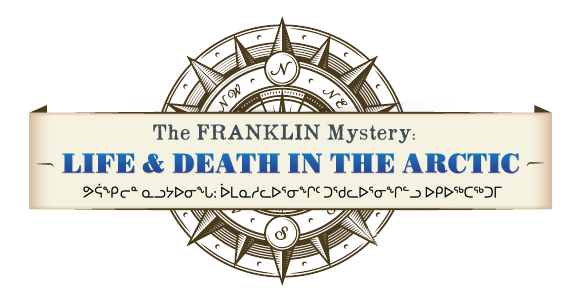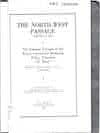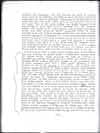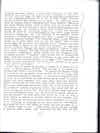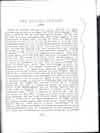The North-West Passage 1940-1942 and 1944 (1954)
What I now would like to tell you concerns our two North-West Passages, the winters, and some of the people we came in contact with. After having loaded our little vessel to full capacity with fuel and provisions for our own need, and also for our Western Arctic Detachments, we left Vancouver at 2:50 a.m. June 23rd, 1940, and proceeded northward through the inside passage as far as the north end of Vancouver Island.
[…]
On arrival at one of these snow villages near Lord Mayor Bay one evening we heard quite a commotion issuing from the largest house. After securing our dogs we crawled in through the passage leading into the house, and much to our surprise found a great big man dressed in an enormous pair of white bearskin pants and a white parka standing in the middle of the house playing a concertina. All around him stood or squatted about 40 Eskimo men, women and children singing “Shall We Gather at the River” in their own tongue. After our mutual surprise they recognized us as white men. The big man shook hands with us and introduced himself as Canon Turner, the Anglican Missionary from Pond Inlet, Baffin Island. He had arrived a day earlier on his annual visit from Baffin Island. After we had shaken hands with everyone, including the small babies, still on their mothers’ backs, where they are carried so as to keep them warm, they continued on with the service, mostly singing, in which we joined. This kept up for about five hours or more, until a large section of the snowhouse roof caved in from the heat of such a large gathering. As the weather was mild outside, it was not worth while building a new roof in the dark. Instead, we all commenced eating, everybody contributing something to the feast. Some of the Eskimos brought in armfuls of frozen fish, while Canon Turner cooked a large pot of rolled oats. We contributed some tea and sugar, also the use of our primus stoves. By the time everyone was through eating, and all the news was swapped between Canon Turner and ourselves, it was after three in the morning. As many of us as possible stretched out on the sleeping platform for a bit of rest; Canon Turner, Corporal Hunt and myself in the center. On each side of us slept an Eskimo family, complete with little children. Between the small babies, which cried at times, and the snoring of the grown-ups, we did not get a great deal of sleep before they started getting up. Corporal Hunt and myself had scarcely dozed off when we were awakened by the tunes from Canon Turner’s concertina. He was standing in the middle of the snow house holding morning service, with a number of Eskimos standing around singing. The chanting voices of the Eskimos lulled us to sleep again, and we did not waken until a plate of porridge was put into our hands by Canon Turner, who was about ready to leave on his homeward journey. At this spot the North-West Passage was again completed. Canon Turner came from England and had arrived from an east coast port of Canada, coming to Baffin Island on the Hudson’s Bay Company steamer “Nascopie”, and crossed over to Boothia by dogs. We had arrived from Vancouver to the west side of Boothia, then travelled around it by dogs. Our meeting with Canon Turner was purely one of chance, neither of us knew of the other’s movements.
[…]
The Return Voyage 1944
While at Halifax during the winter 1943-44 we again received instructions to navigate the North-West Passage. This time we were to use the Lancaster Sound Route. On the way we were to call at Frobisher Bay and bring supplies to our Detachment at Pond Inlet. During the winter we had several alterations carried out to the living quarters so as to be more comfortable and we had a large diesel engine installed. We left Halifax Harbour, July 22nd. The next day we noticed the deck around the exhaust pipe had become very hot, causing the pitch to boil and run; it was therefore necessary to head for Sydney, N.S., to have the exhause [sic] pipe altered. This took us three days, and it was July 26th before we eventually headed northward. We called at Curling Cove, Newfoundland, to fill our oil tanks, as this was the last place on our trip where oil could be obtained. On July 29th we passed through the Strait of Belle Isle. From there the icebergs became very numerous, and we were greatly hampered by fog along the Labrador Coast. No observation could be obtained, and on August 2nd we got a short glimpse of Cape Chidley. Shortly afterwards we obtained a radio bearing from Resolution Island. The weather continued thick and foggy and drift ice now made its appearance. As we could not afford to lose any more time we decided to pass up the call at Frobisher Bay and continue northward. By August 4th we had worked up to Leopold Island, the north side of Cumberland Sound. As we proceeded toward Cape Walshingham, the ice became heavier and we could make no progress. I therefore proceeded across to the Greenland coast, which we sighted on August 6th. On this side there was fine clear weather and open water except for giant icebergs. Off the Great Halibut Bank conditions looked good to westward, so we again crossed over to Baffin Island, and picked up the land around Clyde River.
[…]
We made good time down the Bering Sea and arrived within sight of Akutan Island on October 1st. Early that morning our old enemy returned – fog and dirty weather – but we finally entered Akutan Harbour, and after proper identifications were made to the United States naval officers, were permitted to moor alongside the fueling wharf. Commander Lee and his staff came aboard and heartily greeted us. The officers and sailors, true to American hospitality, as on our previous passage, welcomed us ashore, opened wide their messes, and treated us to a special showing of a movie and a dinner. What pleased us most, though, was that we were able to take a bath. I had not been able to sleep without my clothes on ever since we left Sydney, N.S. It was therefore a treat to be able to relax for a few days. We remained as guests of our good neighbours in this friendly haven until October 4th, when we proceeded to sea for the home run. After an uneventful passage across the Pacific the “St. Roch” entered the inside passage and anchored for the night in Shushartie Bay, October 12th. 6:00 p.m. October 16th we arrived and moored alongside Evans-Coleman-Evans Wharf, Vancouver. Our North-West Passage was over. In 86 days we had travelled 7295 miles. During this time we had only steamed 1031 hours and 34 minutes.

